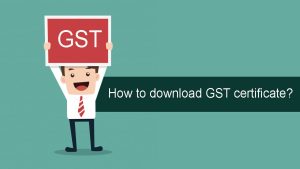GST is imposed on goods and services provided in the country. It has brought uniformity in the indirect tax system by eliminating all of the indirect taxes that prevailed in the pre-GST era, such as VAT, service tax, excise duty, etc.
GST return is a format in which a taxpayer who is enrolled under the Goods and Services Tax (GST) Act must file separately for each registration. The number of GST returns to be filed would also be dependent on the taxpayer type, such as regular taxpayer, composition dealer, e-commerce operator, TDS deductor, non-resident taxpayer, Input Service Distributor(ISD), etc.
Generally, for each GST registration, a daily taxpayer will file two returns per month (GSTR-1, GSTR-3B) and an annual return (GSTR-9/9C) respectively.
Types of GST Returns
GSTR-1
GSTR-1 is the return to be provided for reporting information of all outward supplies of goods and services made, or you can say it as sales transactions made throughout a tax period, as well as for reporting the debit and credit notes issued.
Any changes made to sales invoices, including in relation to previous tax years, should be recorded in the GSTR-1 return.
All regular taxpayers who are enrolled under GST must send GSTR-1. This is to be filed on a monthly basis, other than small taxpayers with revenue up to Rs.1.5 crore in the preceding financial year, who have to file the same quarterly.
GSTR-2A
GSTR-2A is a return that contains information on all inward supplies of goods and services, i.e. purchases made throughout a tax period by registered suppliers.
The information is auto-populated in their GSTR-1 return based on data submitted by the suppliers. GSTR-2A is a read-only return and we can not take any action.
GSTR-2
GSTR-2 is the return for broadcasting inward goods and services supplies, i.e. items purchased throughout a tax period. The information in the return of the GSTR-2 is auto-populated from the GSTR-2A. The GSTR-2 return can be edited as opposed to GSTR-2A.
GSTR-2 is to be submitted by all regular taxpayers registered under GST, but since the implementation of GST the filing has been suspended
GSTR-3
GSTR-3 is a monthly return for the furnishing of detailed information of all outward supplies made, inward supplies obtained, and input tax credit reported, alongside tax liability details and tax payable. This return is auto-generated based on the filed returns GSTR-1 and GSTR-2.
GSTR-3 is to be submitted by all regular taxpayers registered under GST, but since the start of GST, the filing has been halted.
GSTR-3 B
GSTR-3B is a monthly self-declaration to be submitted for the furnishing of summed-up details of all external supplies made, input tax credit claimed, tax liability determined, and tax payable.
All regular taxpayers who are registered under GST must file GSTR-3B.
GSTR-4 / CMP-08
GSTR-4 is the return for taxpayers who have chosen the composition scheme. CMP-08 is the return that substituted the GSTR-4. The Composition Scheme is a scheme where taxpayers with turnover up to Rs.1.5 crores can participate in and pay the taxes mostly on reported turnover at a set rate.
The return to CMP-08 is to be submitted quarterly.
GSTR-5
GSTR-5 is the return to be filed by foreign taxpayers who have been registered under GST and operate a business in India. The return provides descriptions of all the outbound supplies made, obtained inbound supplies, credit/debit notes, tax liability, and taxes paid.
This return has to file on monthly bases
GSTR-6
GSTR-6 is a monthly return that an Input Service Distributor (ISD) will file. This will provide descriptions of the input tax credit that the ISD has obtained and distributed.
These will also provide descriptions of all documentation released for input credit distribution and way of distribution.
GSTR-7
GSTR-7 is a monthly return to be filed under GST by persons who are allowed to deduct TDS (Tax deducted at source). GSTR 7 should include details of the accrued TDS, the payable and charged TDS liability and the estimated TDS refund if any
GSTR-8
GSTR-8 is a monthly return to be submitted by GST-registered e-commerce operators obliged to pay tax at source (TCS). GSTR-8 will contain descriptions of all supplies made via the e-commerce site, as well as the TCS collected on it.
The return has to be filed monthly.
GSTR-9
GSTR-9 is the annual return that taxpayers registered under GST are required to file. It will provide information on all outward supplies made, and inward supplies obtained under various tax headings during the applicable preceding year, i.e. CGST, SGST & IGST, and HSN codes, along with tax information to be charged and payable.
This is a compilation of all the monthly or quarterly returns filed for the year (GSTR-1, GSTR-2A, GSTR-3B).
GSTR-9 is expected to be filed by all taxpayers registered under GST *, with the exception of taxpayers that have chosen for the composition system, casual taxpayers, input service providers, non-resident taxpayers, and TDS payers under section 51 of the CGST Act.
GSTR-9A
GSTR-9A is the annual return paid by taxpayers that have registered for the Composition Scheme. It is a compilation of all the quarterly returns that were filed that year.
GSTR-9C
GSTR-9C is the reconciliation statement to be submitted by all taxpayers whose turnover exceeds Rs.2 Crore. The registered person would have to get a CA or Cost Accountant to audit their account books.
The accounting statement is about these taxpayers’ audited financial statements and the GSTR-9 annual report that was filed.
GSTR-9C is to be filed for each GSTIN so that one PAN can file several GSTR-9C forms.
GSTR-10
It has to be filed by that person whose registration has been canceled or surrendered. This return is often referred to as a final return and must be filed within 3 months from the cancelation or cancelation order date, whichever one is sooner.
GSTR-11
GSTR-11 is the return to be submitted by individuals who have been given a Unique Identification Number (UIN) to seek a refund under GST for the products and services they buy in India. UIN is a designation rendered for non-taxable foreign diplomatic missions and embassies in India in order to receive a tax refund. GSTR-11 will include information on obtained inbound supplies and requested refund.



